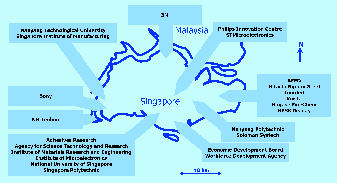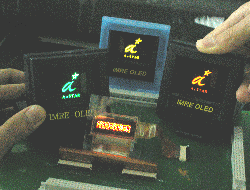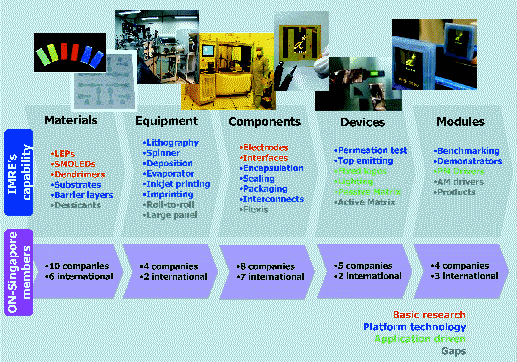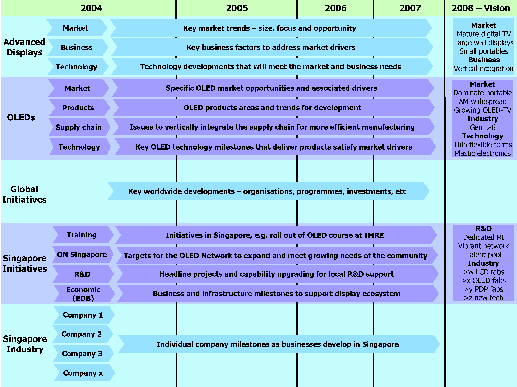Singapore Targets OLEDs
Singapore aims is to become a world leader in advanced displays, and the island nation is developing the technological infrastructure to seed and support OLED design and manufacturing.
by Adrian P. Burden
THERE IS NO DOUBT THAT the focus of commercial display manufacturing is in Asia; prominent countries in the organic light-emitting-diode (OLED) display-manufacturing sector now include Taiwan, South Korea, Japan, and China. Taiwan and South Korea have made enormous internal investments fueled by the success of their liquid-crystal-display (LCD) industries. China is emerging as a significant player not only because of its low-cost manufacturing base, but also because of its proximity to these key players and the enormous domestic market that China offers.
Singapore is vying to be the next country to figure significantly in this commercial activity because it sees that its growing knowledge-based economy aligns well with the intellectual and design-intensive requirements of display technology. However, being a small nation with a population of only 4 million that occupies a land area of just under 700 km2, it has to remain focused on its ambitions.
Singapore's Foundation
For many years, Singapore has been known as a significant center of high-technology manufacturing, particularly in regard to the semiconductor and data-storage industries.
The hard-disk-drive (HDD) industry serves as an excellent case study. Singapore is still a world leader in HDD output (33% of global production by volume), a feat achieved by attracting a community of multinational manufacturing companies, building up a string of small- and medium-sized enterprises to support the industry along the value chain, and then complementing the commercial activity with learned institutes, such as the Data Storage Institute, to undertake research and manpower training.
Coupled with a strategic location in Southeast Asia and a growing reputation for its skilled work force, Singapore remains focused on increasing its activity in the high-technology arena, particularly where it can add value beyond simple manufacturing. One of the key sectors that have been highlighted in the nation's growth strategy is "advanced displays," especially when new and emerging technology is involved. Therefore, the research, development, and manufacture of OLED technology – and the related field of plastic electronics – are a major thrust of Singapore's current activity.

Fig. 1: The expanding display infrastructure in Singapore includes government-supported agencies, academic institutions, and commercial businesses.
The Institute of Materials Research and Engineering (IMRE) is helping to guide these ambitions using its more than 6 years of experience in OLED research and development. IMRE's goal is to provide an integrated technology-driven anchor for new companies wishing to start commercial activities in Singapore by offering trained manpower, technology training workshops, collaborative R&D projects, and specialized analytical and technical services.
By working with other government organizations, such as the Singapore Economic Development Board (EDB), IMRE's staff interacts closely with existing and potential industry players. This is particularly useful when companies visit Singapore and must make informed decisions about the benefits of setting up activities on the island.
Singapore's Status
Singapore has had an efficient and sizeable cathode-ray-tube (CRT) production line operated by Sony for many years. Philips is another company that has had a longstanding presence in Singapore, and recently announced expansion plans at its Philips Innovation Campus as it embarks on its "Connected Planet" initiative, which is very much dependent on display design and technology.
Advanced flat-panel-display (FPD) manufacturing first came to Singapore in 2002 with the opening of the Toshiba Matsushita joint venture called Advanced Flat Panel Displays (AFPD). AFPD was established to manufacture low-temperature-polysilicon (LTPS) thin-film-transistor liquid-crystal-display (TFT-LCD) panels in a US$1 billion facility located in a 35-hectare industrial park dedicated to advanced displays. The AFPD production line is primarily addressing the laptop and flat-screen-television display markets.
It was clear that the local supply chain had weaknesses in its ability to support such activity. So, in parallel with the development of AFPD, a motherglass manufacturer was encouraged to start activities. Now, NH Techno provides Gen 4 and 5 FPD glass on the island. In addition, Hitachi Nippon Steel produces LCD driver chips, Nagase produces specialty chemicals, and Kurita provides ultra-clean water for the display park.
In 2003, Eastgate Technologies announced the formation of a wholly owned subsidiary called Innoled and the company's commitment to invest in a high-volume manufacturing line for polymer-based OLED displays, initially for mobile telephones and other small-display applications. This investment involved partners Cambridge Display Technology (U.K.) and OTB Engineering (The Netherlands) in addition to an agreement to work closely with IMRE. Adhesives Research (U.S.) also opened a technology center in late 2003, highlighting its interest in OLED applications.
Soon after, in 2004, NESS Display (Korea) announced an investment of more than US$40 million to set up a state-of-the-art small-molecule-OLED manufacturing line in the advanced-displays park. This news was followed by an announcement by Solomon Systech (Hong Kong) that it would open an IC-technology center at Nanyang Polytechnic focusing on driver electronic design for the OLED and LCD industries. Other important display-related activities in Singapore are being undertaken by 3M (U.S.) and STMicroelectronics, and at least one additional significant announcement is imminent.
Singapore has two universities, Nanyang Technological University and the National University of Singapore. Both have academic departments active in the research of OLED technology and plastic electronics. Singapore Polytechnic has an LCD and OLED teaching laboratory that trains personnel in the science of manufacturing display modules, while Nanyang Polytechnic is well-known for its engineering-design competence. The research institutes, of which IMRE is one, are members of the Agency for Science Technology and Research (A-STAR). SIMTech (Singapore Institute of Manufacturing Technology) and IME (Institute of Microelectronics) also have some display-related projects, including driver-circuitry and device-packaging R&D. The local distribution of this infrastructure is shown in Fig. 1.

 IMRE
IMRE
Fig. 2: OLED devices fabricated at IMRE include (a) conventional fixed-logo devices, a top-emitting device, a passive-matrix device, and (b) a transparent passive-matrix polymer-OLED device.
Technical Capability
Many of the issues that have hindered OLED commercialization were materials-based, and much of the work that continues worldwide is focusing on new classes of materials for enhanced lifetime, reduced degradation, improved environmental barriers, and better efficiency. This places IMRE in a good position to support manufacturing activity in Singapore.
IMRE's R&D capability now extends to small-molecule- and polymer-based OLED materials and devices. Although previously much of its R&D was aimed at understanding the fundamental issues of OLED technology, it has also worked with a number of multi-national companies on more-applied projects. Recently, this aspect has been promoted so that the relationships that are built on collaborative projects may be used to catalyze commercial activity and manufacturing.
IMRE itself has made a variety of devices (Fig. 2), including conventional fixed-logo devices, top-emitting structures, passive-matrix devices, and light-emitting materials formulated in-house. In addition, IMRE scientists and engineers have produced devices on flexible substrates, have begun employing enhanced encapsulation layers, and have developed a technique to measure moisture permeation to high degrees of sensitivity. Developing this range of competencies is designed not only to provide research breakthroughs that generate intellectual property, but also to help develop a good understanding of the technical issues that are faced in this area so that there is a sound local knowledge base which local enterprises can leverage.
Value-Chain Analysis and ON-Singapore
The manufacture of OLEDs requires a complex and dedicated supply-chain infrastructure. This is something Singapore must strengthen as it begins to compete with more-established display-manufacturing countries. IMRE has taken a critical look at the supply-chain issues from a technical perspective and started to target companies that may be able to contribute.
One role that IMRE is able to play is educating existing local companies that are working in related fields. For example, Singapore already has a significant chemical industry, equipment-manufacturing industry, and electronics fabrication and packaging capabilities. Much of this is currently related to other industry sectors, such as the HDD and semiconductor/photonics industries. As companies are made aware of the new OLED opportunity, they are invariably receptive and see this as a new commercial activity to sustain their businesses as the more mature industries move on.

Fig. 3: IMRE serves as a multifaceted support structure for OLED R&D in Singapore.
To accelerate this activity, IMRE launched the OLED Network of Singapore (ON-Singapore) with the support of the EDB in early 2004. The current membership includes multinational participants, local enterprises, display manufacturers, and possibly some unexpected companies with a growing interest in OLEDs (Fig. 3). Moreover, the membership has evolved to span the value chain.
ON-Singapore has also organized a number of seminars and events, attracting speakers from overseas to discuss the business, marketing, and technical aspects of OLEDs. In addition, it has on-line resources that link and update members, helping to forge a new advanced-technology community. ON-Singapore also provides a conduit through which to offer training workshops and discounted collaborative projects that leverage IMRE's technical staff and infrastructure. More recently, it has started to liaise with the Workforce Development Agency (WDA) to address some of the growing requirements for skilled manpower as this industry takes hold.
Technology Roadmap
Another major initiative being led by the ON-Singapore team is the construction and hosting of the Advanced Displays Roadmap of Singapore. The ON-Singapore membership already has access to a first-cut version of this roadmap, so they can plan how their respective companies can align to the expected growth of this new sector (Fig. 4).
The full content of the roadmap cannot yet be published, but some of the visions and trends can be revealed. The roadmap was constructed by pulling together worldwide industry information, discussing macro-economic plans with the EDB, assessing local academic R&D projects, and including insights from ON-Singapore corporate members. As the road-map is refined in the future, it is hoped that more of the membership will be able to provide key milestones, which will in turn help make the sector operate more efficiently.

Fig. 4: The Advanced Displays Roadmap of Singapore has been created by IMRE and the EDB, and is now hosted and updated by ON-Singapore.
A Personal Vision
Singapore is poised to reap substantial economic rewards from its investments in the advanced-display industry, as long as com-mitment and focus are maintained. Moreover, since advanced displays constitute such a dynamic industry, Singapore must look for a sustainable advantage and a niche competency that sets it apart from its neighbors.
Among Singapore's strengths are its unique environment of an exceptionally well-funded government R&D infrastructure, a respected legal system to protect intellectual property, and a distinctive mix of multinational companies alongside a growing range of capable small- and medium-sized enterprises. The provision of technical support attracts more activity, so one day Singapore will have a dedicated display-technology institute to provide that anchor.
Part of this vision also includes a display-prototyping line that would not only allow the demonstration of emerging technology from the R&D programs undertaken within the academic community, but would also enable companies to buy time on the equipment so that they could confidently try out new materials, new device formats, and new processing techniques. Such a facility would greatly assist companies by reducing their up-front capital expenditures, and would help attract smaller, more-agile enterprises to the commercial ecosystem.
Singapore also has the opportunity to capitalize on other related panel technologies, particularly in the polymer electronics field. Among these are arrays of organic photo-detectors, photovoltaics, and organic transistor-based circuits. These technologies have much in common with the OLED-platform technology, particularly as the systems migrate to flexible substrates. Innovative products based on these technologies could provide Singapore with the means to capture a lucrative and sustainable new market for the future. •
Adrian P. Burden is a Business Development Manager and Senior Research Engineer at the Institute of Materials Research and Engineering, 3 Research Link, Singapore 117602; telephone +65-6874-8350, fax +65-6872-0785, e-mail: adrian-pb@imre.a-star.edu.sg. The author acknowledges the contributions of his colleagues at IMRE, at the Agency for Science Technology and Research (A-STAR), and at the Singapore Economic Development Board.